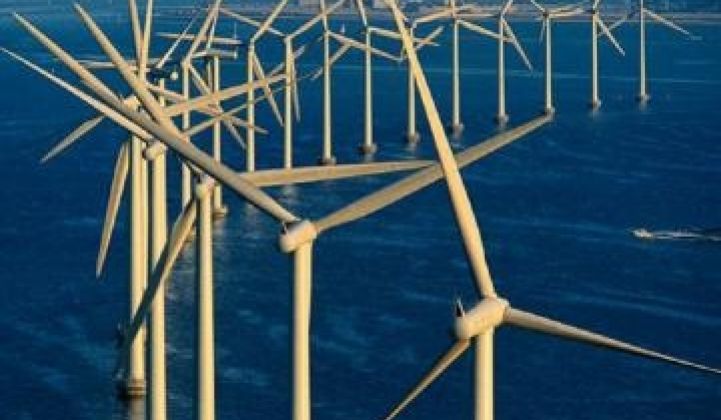Though the Gulf catastrophe has opened the nation's collective mind about the enormous potential of offshore wind, BP's behavior has also, ironically, made offshore wind's path through the regulatory maze more difficult.
That's because the Minerals Management Service (MMS) -- the agency under fire for allegedly failing to adequately police BP -- now plays a key role in the approval process. Perhaps understandably, MMS is a little skittish these days.
"Secretary Salazar is a very strong advocate and very strongly committed to offshore wind development," said Jim Lanard, Managing Director of Deepwater Wind, one of the most active offshore wind developers, adding that it is "very unlikely" that the Gulf oil spill ultimately will have a detrimental impact on offshore wind development over the long term.
But in the near term, "things have come to a standstill, pretty much, while all attention is focused on the oil and gas," Lanard said.
The Obama Administration came to office with a commitment to offshore wind's potential to provide emissions-free electricity. The Mid-Atlantic coast, where offshore wind will likely first be developed, has an estimated 330 gigawatts of potential, enough to meet East coast electricity demand several times over. Secretary Ken Salazar, soon after his appointment to head the Department of the Interior (DOI), began opening up the ocean energy potential of the U.S. outer continental shelf (OCS).
Within months, Secretary Salazar pushed through clarification of jurisdictional disputes between the MMS and the Federal Energy Regulatory Commission (FERC) in an effort to simplify the complex labyrinth of environmental and multi-agency procedures that make offshore wind approval an onerous seven-to-nine-year process.
A new regulatory regime was nearly ready and Secretary Salazar was announcing final approval for Cape Wind, the much-delayed and long-awaited first U.S. offshore project, when BP blew its blowout preventer.
The head of the MMS resigned, and the new appointee, Michael Bromwich, still must be confirmed. Chris Oynes, an associate director whose role is key to the oil and gas permitting process at the DOI, had only just begun work on offshore wind permitting when he became one of the first to resign in the aftermath of the Gulf disaster. "There's a leadership vacuum right now," Lanard acknowledged.
One of the most important suggested solutions for an improved offshore wind approval process is the granting to developers of a "categorical exclusion" from certain environmental study obligations on the grounds that such studies have been conducted time and again and new ones would only yield the same results.
Unfortunately, before the MMS got around to granting wind such categorical exclusions, there was that oily matter in the Gulf of Mexico. In the catastrophe's wake, it was discovered that one of the corners cut on behalf of BP was the granting of a categorical exclusion.
It has long been the common practice to grant offshore oil and gas drillers such exclusions, and it probably had little to do with the disaster that BP's alleged shoddy drilling practices has precipitated. But never mind anybody else asking for such an exclusion right now.
"Because of the fact that BP got one of these categorical exclusions for the Deepwater Horizon operation, proposing now that offshore wind should be eligible for some categorical exclusions for certain activities [would be] bad timing," Lanard said.
Being granted such a privilege at this point would be imitating BP's behavior -- and it could alienate offshore wind developers' allies in the environmental community.
"We think that the policy we were proposing was right," Lanard said. "But the politics are wrong right now."
Nonetheless, the overall goals for wind aren't being questioned and will likely resurface. Salazar understands that a seven-to-nine-year permitting process is not feasible. "As the Secretary said," Lanard observed about the extended approval timeline, "we'll never attract investors, we'll never attract manufacturers, we won't create an industry, and if we don't create an industry we're not going to be building offshore wind in the United States."
Walt Musial, the principal engineer and offshore wind leader at the National Renewable Energy Laboratory, has concluded that for the time being, MMS is being pulled in opposite directions. "On one hand, MMS is getting slammed," he said, "for being too lenient on the oil companies and for being 'too cozy' with the industry." Meanwhile, Cape Wind "had to go through nine years [of multi-agency regulatory scrutiny] and no one could possibly come up with a worst-case scenario that is even close to what is happening now in the Gulf."
On the other hand, Musial said, "they're still gun-shy about this 'cozying up to industry' accusation they're being faced with right now, so that's going to drive them toward stricter standards for wind and for everything on the outer continental shelf." But "if oil is so risky, shouldn't we be looking for alternatives?" he asked, and then answered his own question. The MMS is "being driven" toward simplified regulations, but "that tug-of-war hasn't played out yet."
Lanard said he is "cautiously optimistic" about the changes at the MMS. "As they regulate and re-regulate oil and gas," Salazar's DOI is, Lanard believes, looking for a way to distinctly separate offshore oil and gas scrutiny from offshore wind scrutiny, because "they're as different as night and day."



